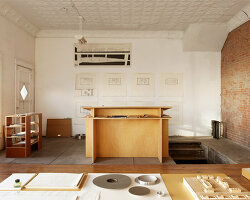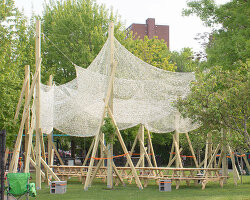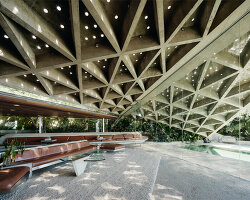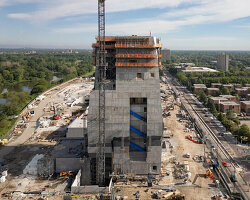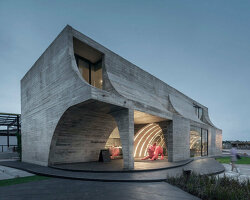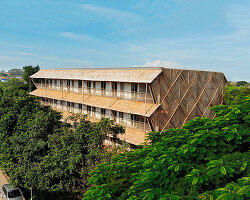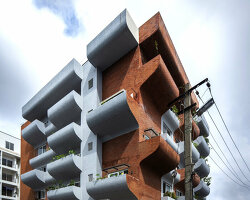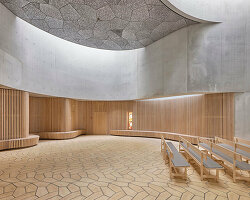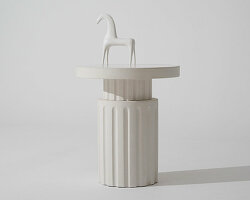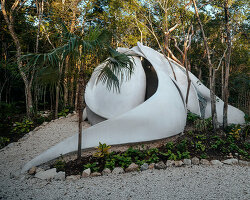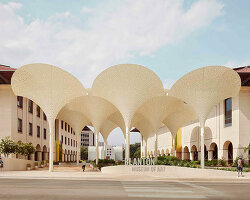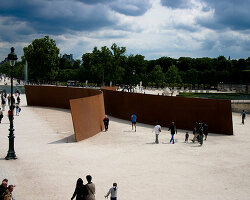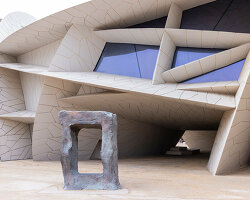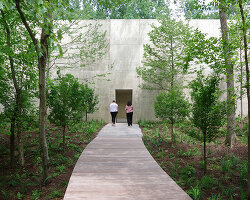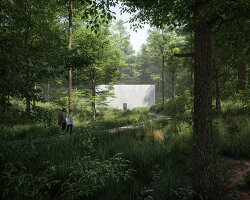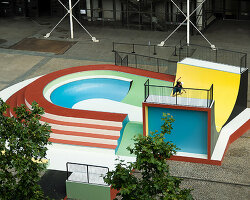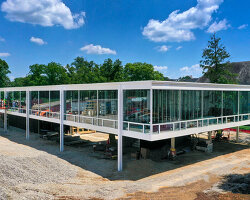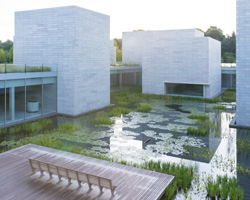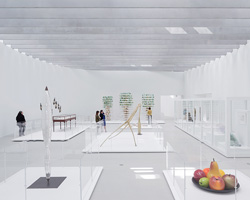glenstone museum’s worldwide digital film premiere
Celebrating the completion of its newest building by Thomas Phifer and Partners, Glenstone Museum premieres its short film titled ‘You Are The Subject: Richard Serra at Glenstone.’ The film follows the installation of Richard Serra‘s sculpture ‘Four Rounds: Equal Weight, Unequal Measure’, 2017 in the new Pavilion which had been created specifically to house the colossal work. While the film showed last month at Montreal’s international film festival Le FiFA 2023, it is now being unveiled by producers Glenstone Museum and Rava Films with designboom in a worldwide digital premiere.
In time for the film’s premiere, designboom spoke with Thomas Phifer about his collaboration with Richard Serra and how the architecture was informed by the sculpture inside.
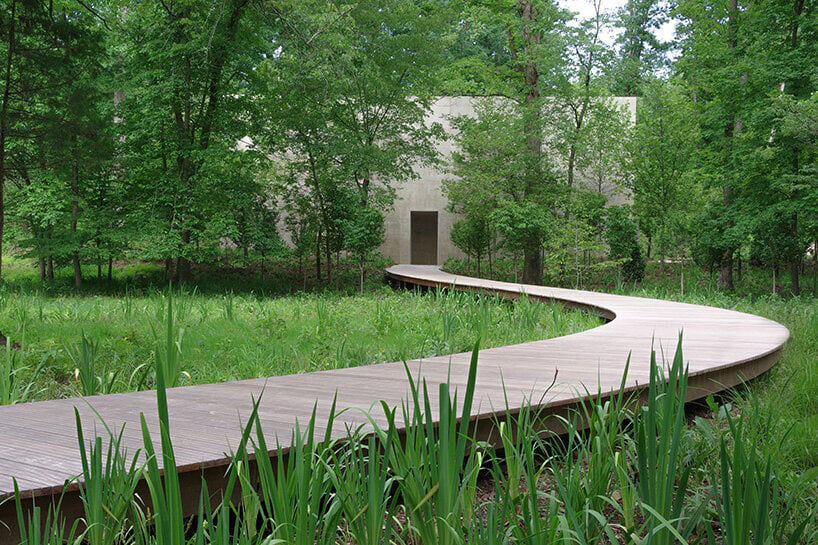 approaching the new building by Thomas Phifer and Partners | images courtesy Glenstone Museum
approaching the new building by Thomas Phifer and Partners | images courtesy Glenstone Museum
serra and phifer’s collaboration at glenstone
Joining the larger collection of Pavilions at the Glenstone Museum, completed by Thomas Phifer and Partners in August 2018, this new building was completed in June 2022; the result of a collaborative effort between architect and artist. While it functions as a vessel for the sculpture, ‘Four Rounds: Equal Weight, Unequal Measure,’ the structure is itself a continuation of the artwork inside. It is removed from the rest of the museum, quietly hidden amidst the wooded landscape in Potomac, Maryland. As visitors approach along a meandering footpath, the concrete building gradually unfolds from behind the trees, the monolithic artwork soon to be discovered within.
‘Four Rounds: Equal Weight, Unequal Measure’ takes shape as a single work composed of four cylindrical forms forged from solid steel. Although ranging in height, diameter and volume, each form weighs precisely 82 tons — the heaviest form that a foundry is able to forge. The surface of each form carries a rich, textured patina imprinted by the intense pressure of the forging process. The sculpture was created in 2017 while the Pavilions at the Glenstone Museum were nearing completion, and just before Thomas Phifer and Partners began work on this newest building.
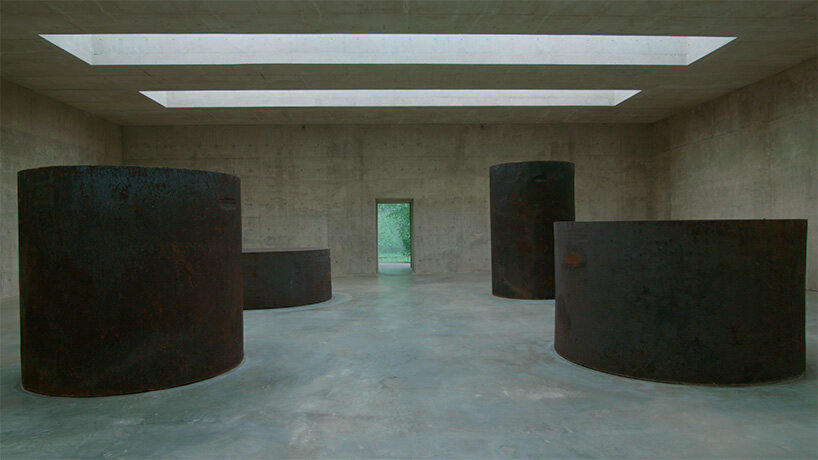 ‘Four Rounds: Equal Weight, Unequal Measure’ 2017 by Richard Serra installed at Glenstone Museum
‘Four Rounds: Equal Weight, Unequal Measure’ 2017 by Richard Serra installed at Glenstone Museum
washed in natural light
‘Four Rounds: Equal Weight, Unequal Measure’ 2017 now stands as the third artwork by Richard Serra at the Glenstone Museum. ‘Sylvester,’ 2001 and ‘Contour 290,’ 2004 occupy the grounds surrounding the Pavilions, and are backdropped by the rolling landscape. These two sculptures are showcased as part of the film ‘You Are The Subject: Richard Serra at Glenstone’ to demonstrate the contrast between Serra’s works outdoors and indoors.
One key correlation between these three artworks is that they are each displayed under natural sunlight. Designing the new building, Thomas Phifer and Partners had carried out a careful series of lighting studies to ensure the four rounds were washed uniformly with ambient sunlight. Ultimately the team landed on an array of four elongated skylights which cut deep into the thick structure and are enclosed with white glass. Thus, the texture of the oxidized steel surfaces are spotlighted together with their backdrop of raw concrete.
Follow the building’s design and construction along with the sculpture’s installation in this newly premiered film, together with designboom’s interview with architect Thomas Phifer below.
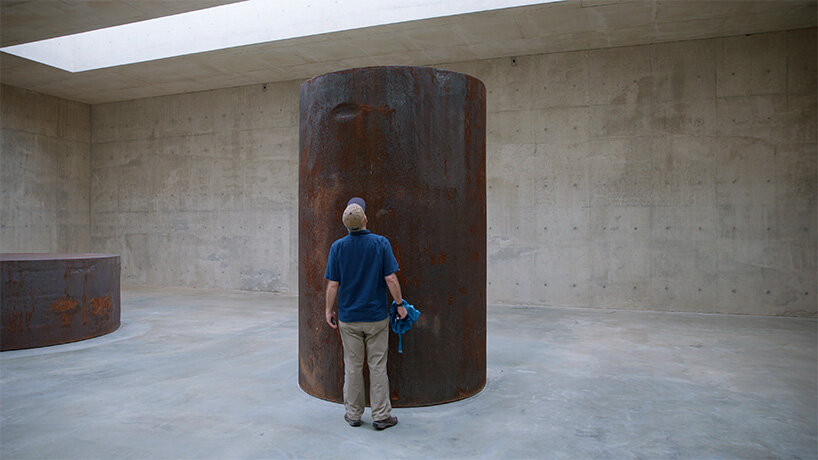 each of the four rounds weighs eighty-two tons
each of the four rounds weighs eighty-two tons
designboom (DB): When designing a museum or gallery, it can be difficult to strike a balance between how much the art itself should shine, and how much the architecture around it should shine. This project is unique because the building is an extension of the sculpture. Can you elaborate on this concept?
Thomas Phifer (TP): I think that room in the woods is like the rooms in the pavilions. Because it brings this frame to particular, mostly singular works. It brings a frame to the artist. Rather than them being big, open, flexible spaces, they’re in very particular spaces that are worked on in concert with the artist. This pavilion is sitting out in the woods — and Richard Serra’s work is akin to rooms in the pavilion. With light, proportion, and space, it frames those works and causes that to be the lens through which you see those works.
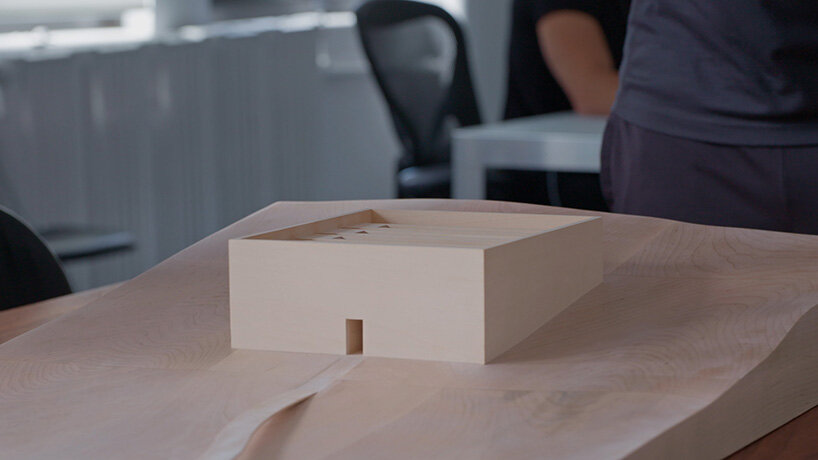 physical model by Thomas Phifer and Partners
physical model by Thomas Phifer and Partners
It’s just like in the pavilions. Every one of them has this way of providing a threshold, and a preparation to see the work. Some of those rooms in the pavilions have very thick walls. You go from one of the pavilions out back, and you look at the pool. And you then come from the pool, and you move to another room. Then you go through a thick wall, and you go from light, to shade, to shadow. Then back into the light. Here, you walk through the woods and the wetlands. Then you walk through this really small opening to enter into this room, and it’s completely filled with daylight. There are so many similarities between this pavilion and the others.
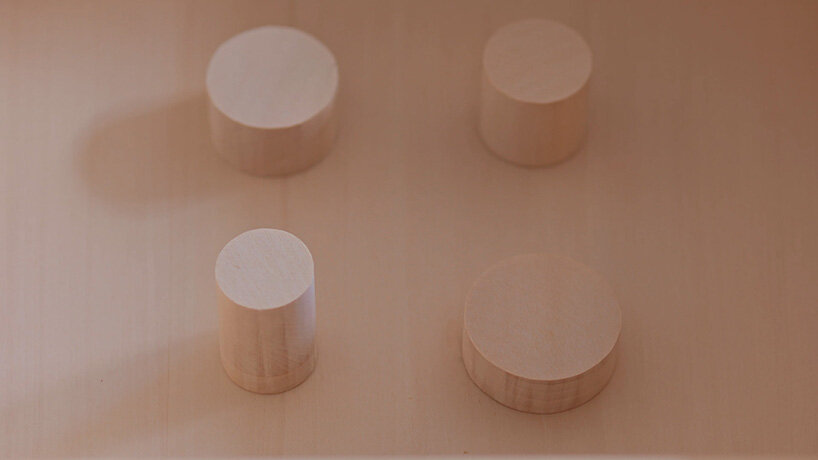 physical model of the sculpture
physical model of the sculpture
DB: Approaching the pavilion through the woods, the experience unfolds gradually.
TP: You have time to prepare yourself! These artworks are really amazing — and pretty powerful. So to have this kind of preparation where you walk through nature, the worries of the day drop away, and you’re walking through the woods and over the wetlands on the boardwalk and then all of a sudden you come through the small door, through a pretty thick wall — and you’re in.
DB: In the film it’s said that Richard Serra considers this sculpture as one piece: ‘its four elements, the space around them, and the space in-between them.’ One could say that your pavilions can be experienced in this way as well. Is this by chance, or was this intentional?
TP: I had certainly never designed a museum with nine or ten spaces in perpetuity, with one particular artist. Clearly, when you walk into Richard Serra’s room, you see that work that he’s made is not separated from the space itself. It’s hard to disconnect the two. Whereas if you walk into MoMA and you see a room with ten or twelve pictures on the wall, you don’t think of those works all coming together and the room being a part of it. But when it’s just one artist, you do get the sense that those four rounds belong to that room.
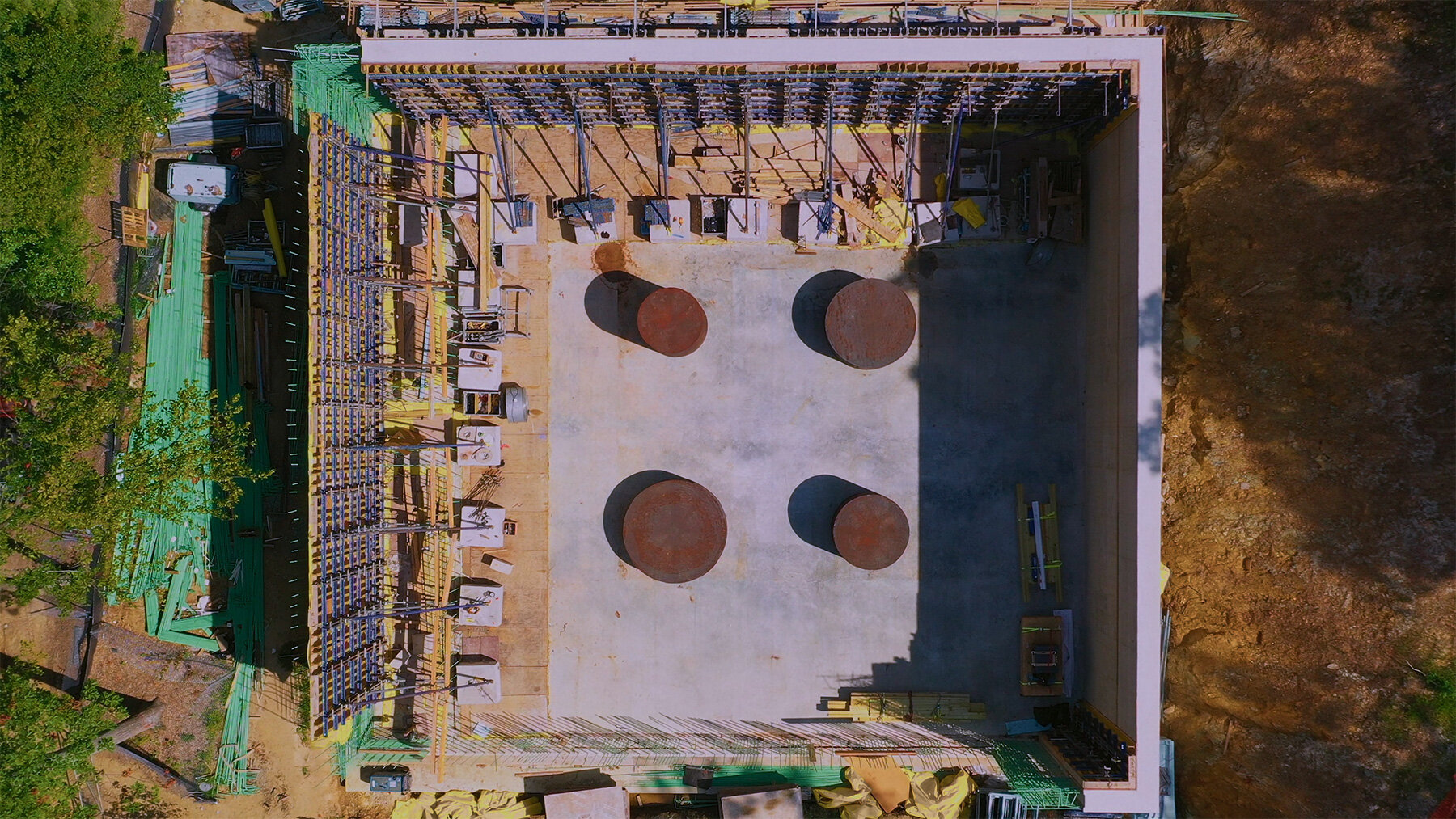
DB: In what ways is working directly with an artist unique as an architect when designing museums or galleries — especially such an iconic artist?
TP: Richard Serra is a rock star — there’s no better sculptor, certainly in my generation. So to work with him on making this room was an amazing experience. We worked on the proportion of the room together. It was very important for him that the daylight inside was all filtered light. He didn’t want any direct light. The light is diffused so that every one of his works is lit evenly. Whereas if the sunshine was able to come through directly, then the sculptures would have cast shadows on the floor and one side would have been brighter than the other side. He wanted the works to be completely evenly lit.
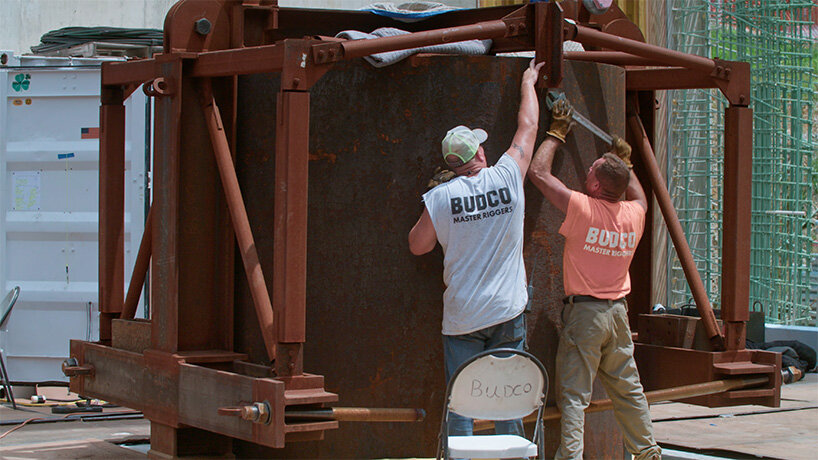 the installation process
the installation process
DB: How do the skylights diffuse the daylight? What did you learn or reject during your light studies designing the new pavilion?
TP: We knew that we wanted to put these slots in the ceiling. Because that seemed abstract and simple. But we calibrated and tuned how big the slots were, and how close they were to the walls. All of that is tuned very carefully. If they are too far apart, it’s darker in the middle — and you don’t want any ribbons on the floor.
The exact distance of each skylight from the walls had to be calibrated. We wanted the skylights to light those walls, but we didn’t want to locate them right next to the walls. Because then you begin to read the shadows from the concrete and it becomes a distraction. So every one of those big slots in the ceiling was calibrated and tuned, making sure there was good, even light over his works. That was really important to him.
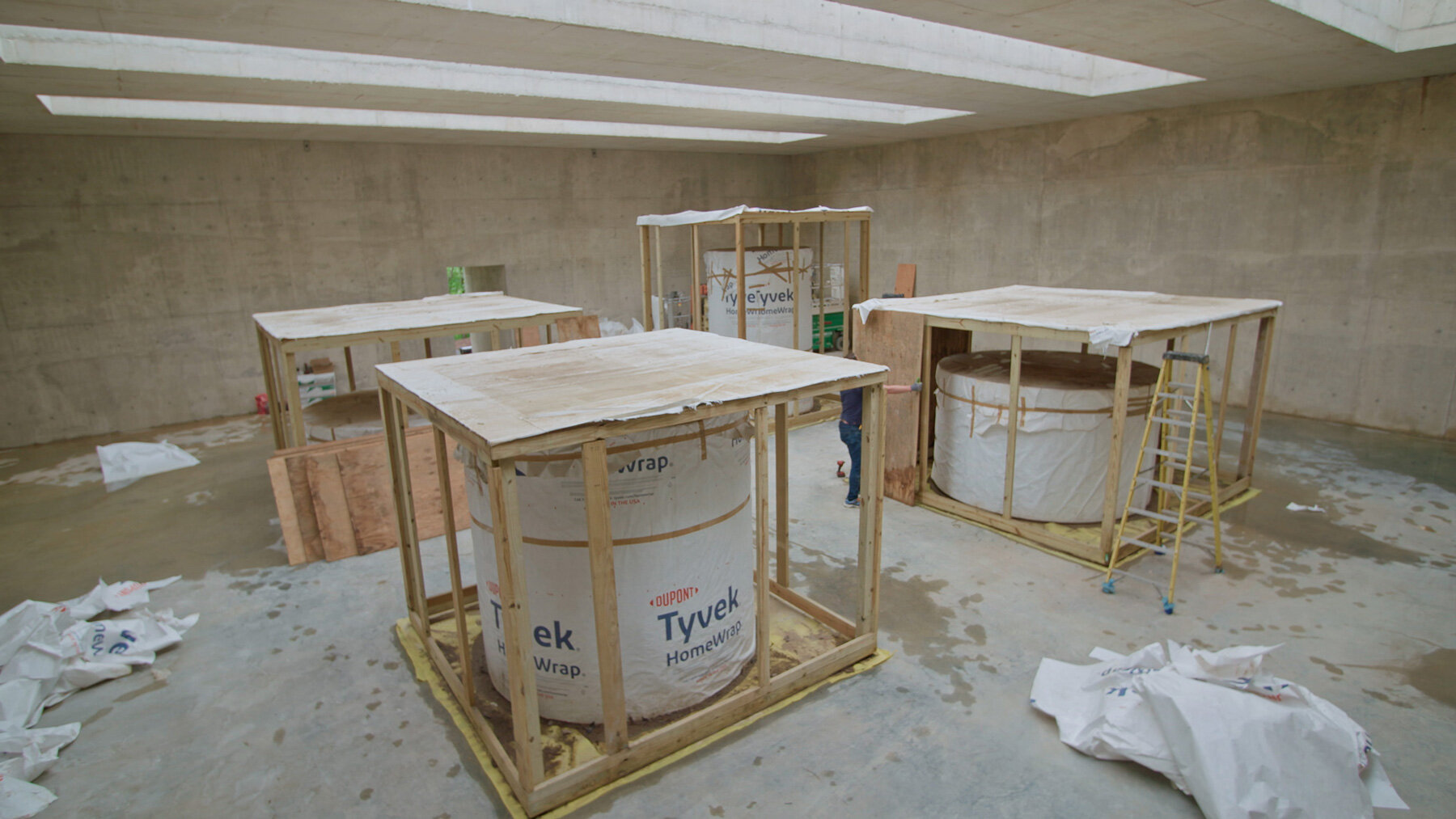
the installation process
DB: Oftentimes, museums require very strict lighting systems. But the Glenstone Museum, especially the new building, makes very little use of artificial lighting. What are the unique challenges in designing a naturally-lit museum?
TP: Most of the rooms in the Pavilions are naturally lit. The lights are often turned off as you walk around. Because architecture is about light, but it is this architecture through light — shade and deep shadow belong to the light. They’re not separate from the light. So by coming through the woods, for instance, in the springtime with dappled light and moving into the sunshine, you move through this deep, shaded passage there, and then you come back into the light. The light is the thing that kind of choreographs and marks your movement.
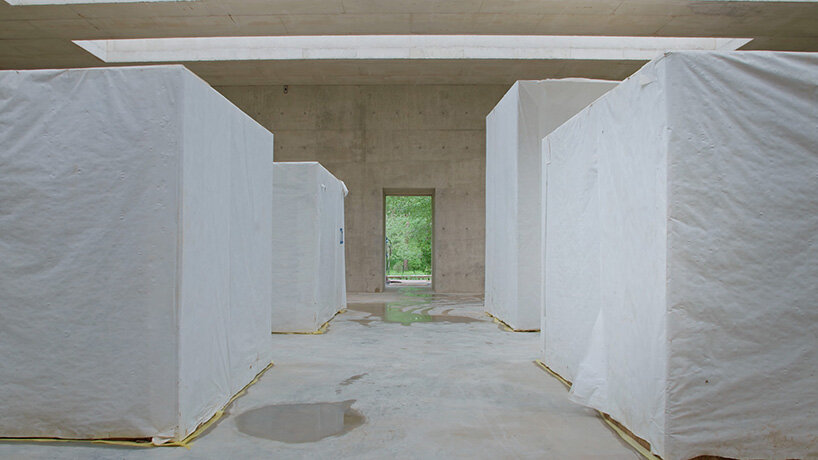
‘Four Rounds: Equal Weight, Unequal Measure’ before unboxing
DB: Much of the overall museum is defined by its relationship with the landscape — with the restored woodlands, buildings embedded into the hill, and boardwalks floating over the wetland. How did you balance necessary excavations and constructions with this sensitivity to nature?
TP: You certainly want to build and not cut down trees. That’s what happened here. We basically just nestled it back into the hill. We wanted to build there because people had built there before — there were other buildings. I do a lot of hiking in Switzerland. In Switzerland, when people want to build in the villages there, they have to take down a building that’s already been built in order to build a new building. Where the pavilions were built, there was this beautiful peninsula of land with barns on it. So we took the barns away. And then we softly placed these pavilions into the land. And then we carve the peninsula out to make the pool so that the hill in essence, the mound, could come right up in over the top.
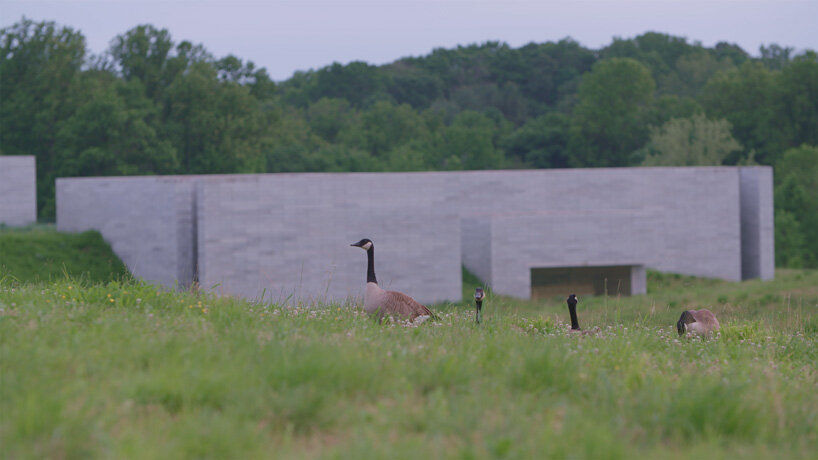 the Pavilions at Glenstone Museum
the Pavilions at Glenstone Museum
As a precedent, we referenced Michael Heizer’s land art out in the desert. He carved these enormous voids in the desert. When you walk down in there you are below the earth and you’re framing the sky. And having that experience was one of the greatest land artworks ever. So the idea behind the pavilions was to descend into the middle of this mound. So we carved it out, so that pool basically framed the sky. You then walk around the knoll underneath. And we put the earth back exactly the way that it was.
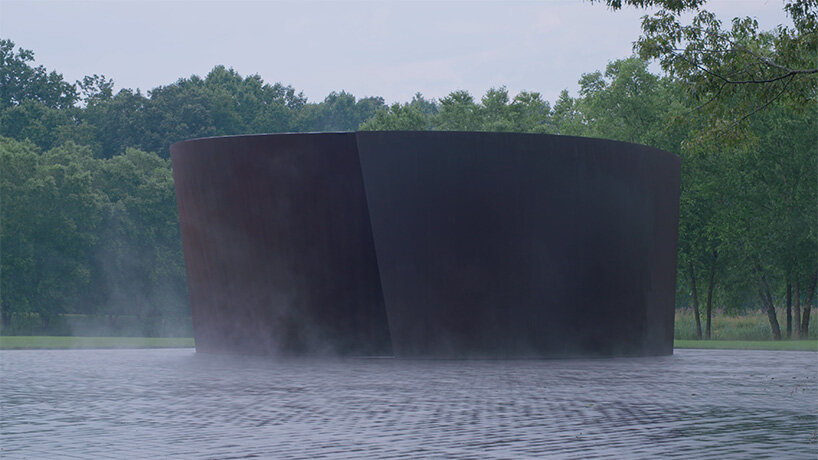 ‘Sylvester’ 2001
‘Sylvester’ 2001
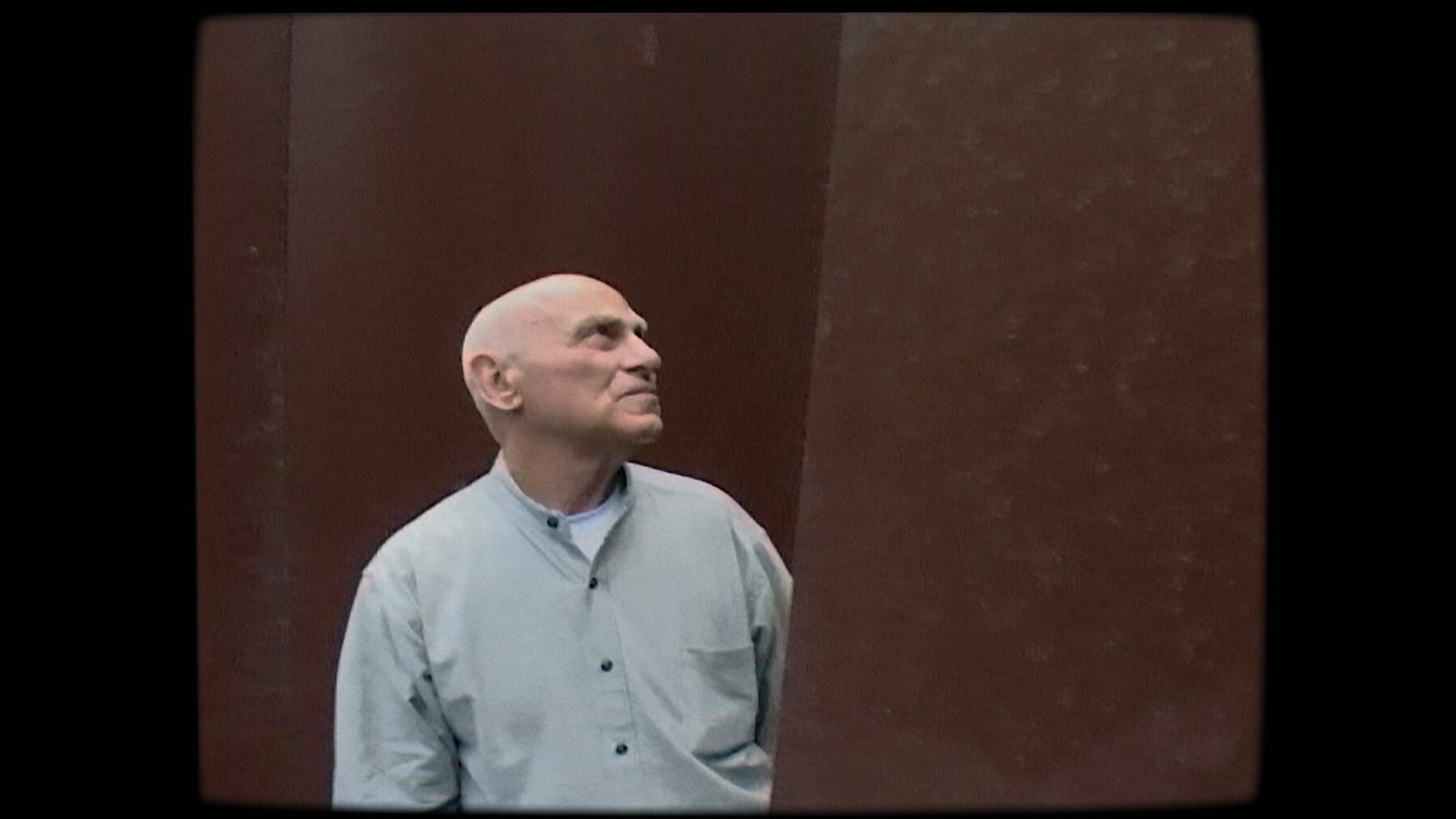
Richard Serra viewing ‘Sylvester’ at the Glenstone Museum
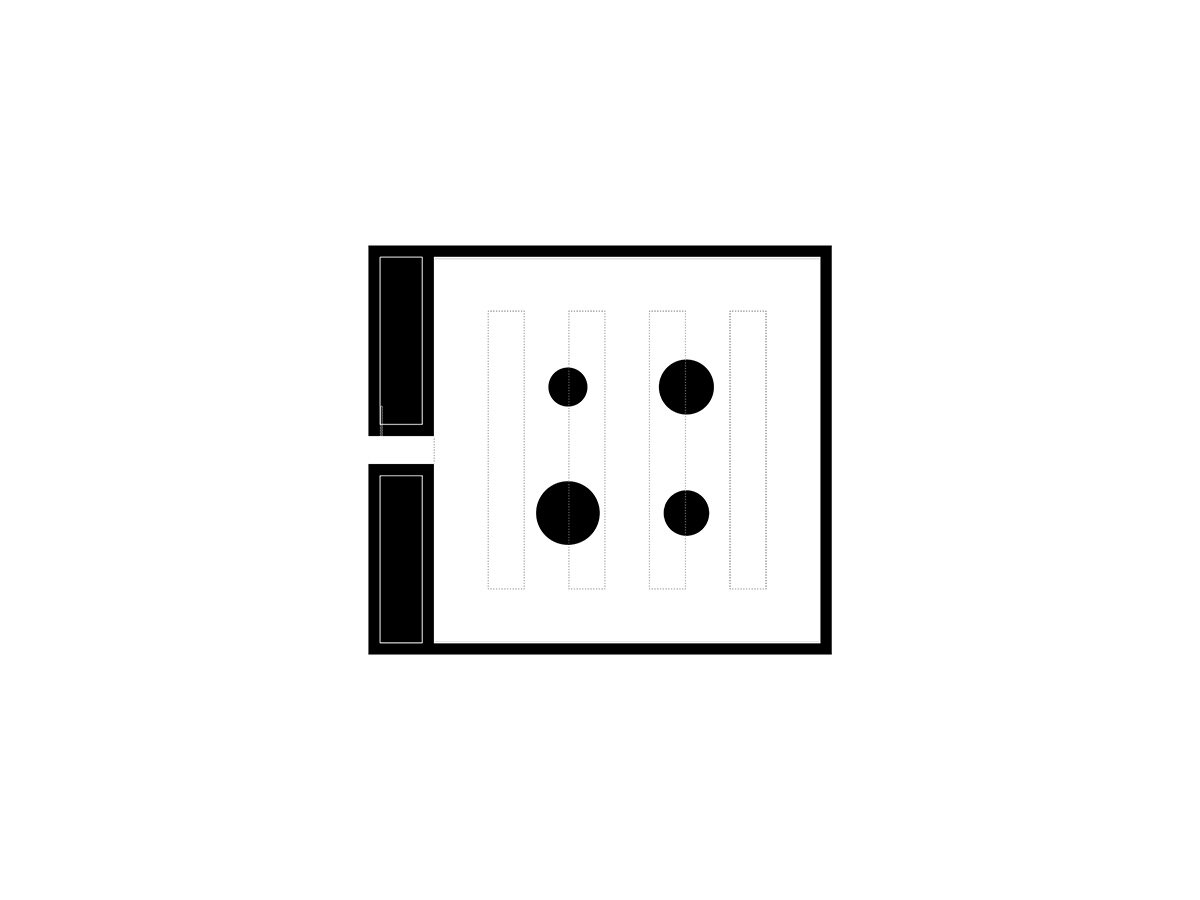
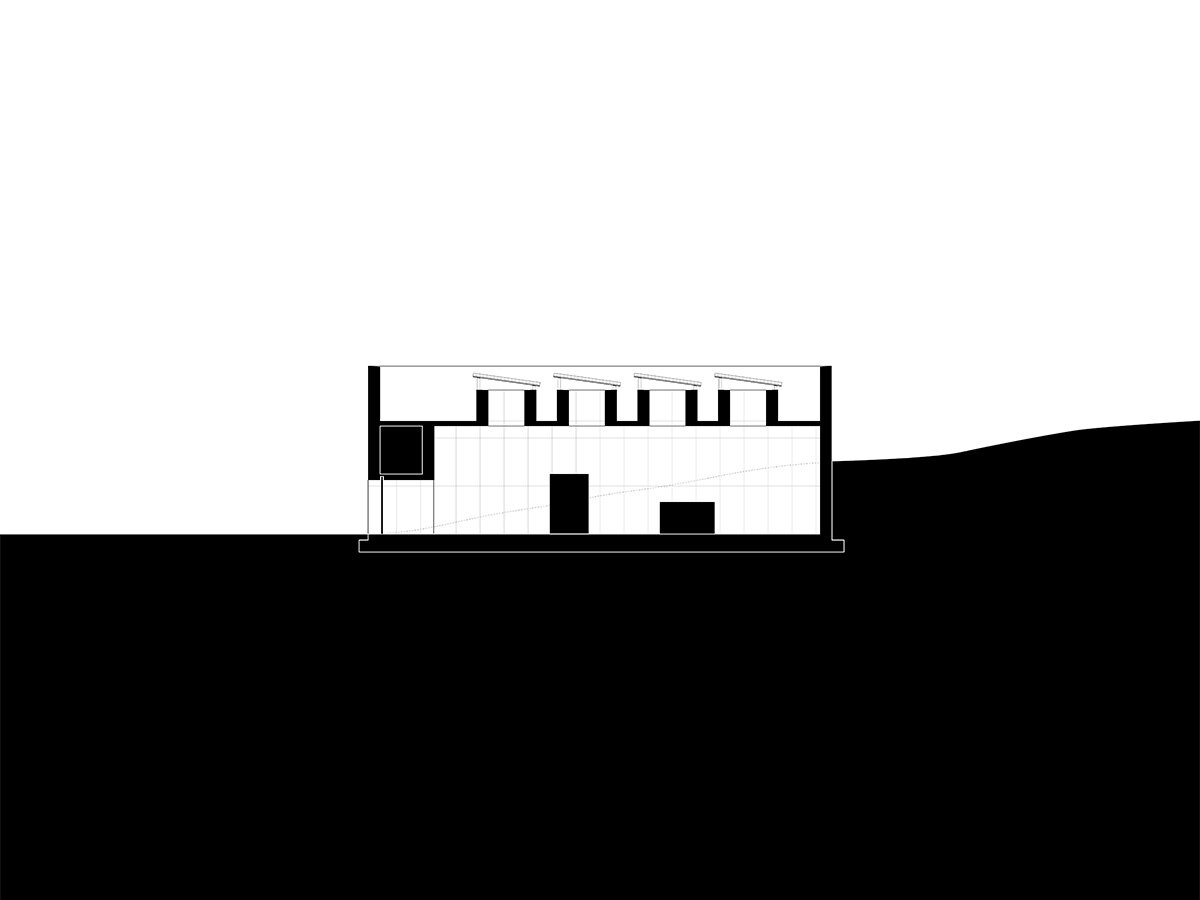
project info:
film title: ‘You Are The Subject: Richard Serra at Glenstone’
film producers: Glenstone Museum, Rava Films
location: Glenstone Museum, Potomac, Maryland
architecture: Thomas Phifer and Partners
artist: Richard Serra
sculpture: Four Rounds: Equal Weight, Unequal Measure, 2017
architecture in the US (1507)
concrete architecture and design (723)
museums and galleries (677)
richard serra (10)
sculpture (374)
thomas phifer and partners (9)
PRODUCT LIBRARY
a diverse digital database that acts as a valuable guide in gaining insight and information about a product directly from the manufacturer, and serves as a rich reference point in developing a project or scheme.
